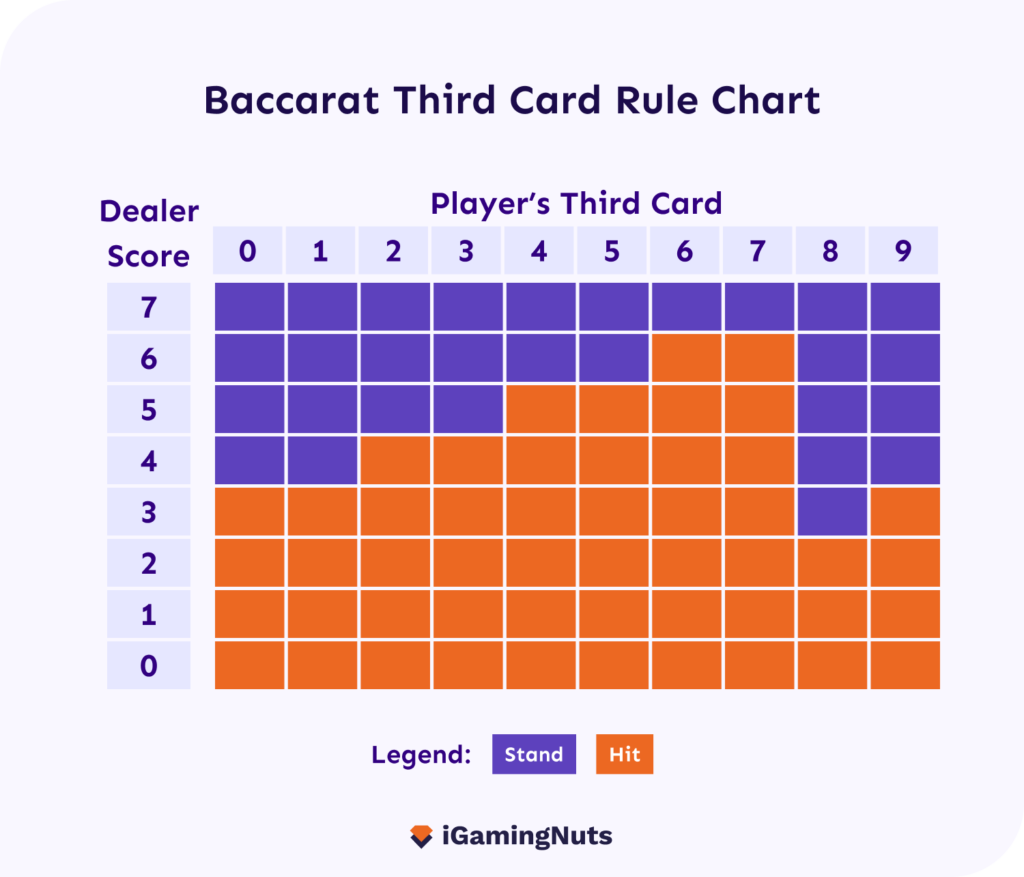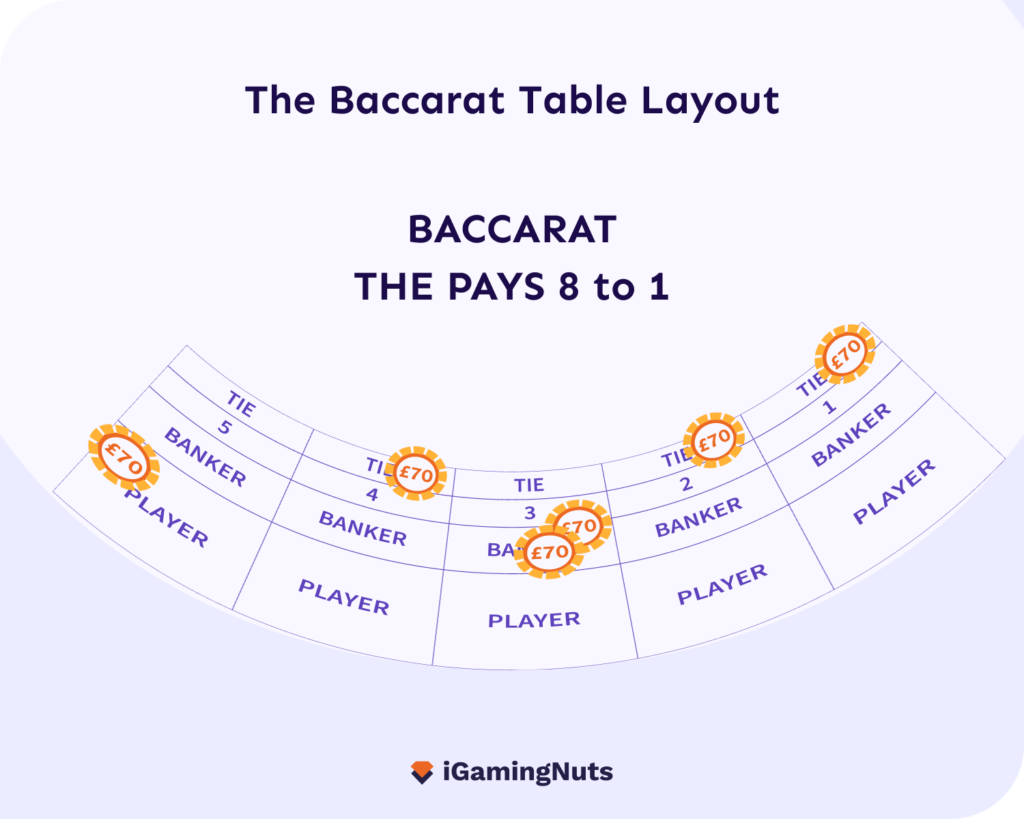How to Play Baccarat Online
Although Baccarat may appear complicated to beginners, in truth, it is actually one of the easiest casino games to play. A favourite game of many casino players, including James Bond by the way, Baccarat is sleek, stylish and simple. In this guide, we’ll show you how to play baccarat online, including all the rules, card values and betting options you need to make you a confident player.
- Baccarat Rules
- Main and Side Bets
- Baccarat Variants
- Things to Remember When Playing
- Step-by-Step Guide
- FAQs
Basic Rules of Baccarat
The most common version of Baccarat is Punto Banco, so we’ll focus on that to start with. We can then delve into some more niche Baccarat variations later.
The overall rules of Baccarat make it a straightforward contest between two hands—known as the ‘Player’ and ‘Banker’ You win by correctly betting on which will finish closest to 9.
It is important to know that in Baccarat rules the terms ‘Player’ and ‘Banker’ do not refer to specific people, but to the hands themselves. You are not the ‘Player’, and the casino is not the ‘Banker’. These are general terms used to present two different hands and you are free to bet on either side.
When playing Baccarat, you are therefore not drawing cards, making decisions or playing against the dealer, you are simply betting on an outcome. In very basic terms its like betting on a coin flip.
How does Baccarat work?
There are only three possible outcomes in Baccarat: Player wins, Banker wins, or Tie. Most players bet on either player or banker, because the odds of winning the tie bet winning are so low.
The game begins with players deciding which bet(s) to place. Once players place their bets, the dealer deals two cards for the Player and two for the Banker. The cards are then revealed, leading to four possible outcomes:
- There is a clear winner (a tie or a natural 8 or 9)
- The player needs a third card
- The banker needs a third card
- Both the player and banker need a third card
The decision on whether a third card is needed is not decided by you or the dealer. It is predetermined by Baccarat rules based on the values of the dealt cards. We’ll go into this in more detail below.
Once a winner has been established (either player, banker or tie), the dealer pays out on all winning bets and the game starts again. Now, lets take a look at the Baccarat rules for card values.
Baccarat Card Values
You could say that Baccarat resembles Blackjack because both games revolve around hitting an optimal score – 21 in Blackjack, 9 in Baccarat. However, the games have fundamental differences, the main one being the card values.
In Baccarat, the dealer generally uses six or eight decks of cards and places them in a shoe, a device that holds multiple decks of shuffled cards. The game uses all cards except jokers, with the following values
- Numbers 2 to 9 – their face value – 2 to 9 points
- 10, Jack, Queen and King – 0 points
- Aces – 1 point
Another difference is that it is not possible to ‘bust’ in Baccarat. When the cards add up to more than nine points, you deduct ten points from the total to keep the score between zero and eight.
Some examples of this are below:
- 5 and a 6, for a total of 11 points, counts as a score of 1
- Jack and a 4, for a total of 14 points, counts as a score of 4
- Ace and a 7, for a total of 8 points, counts as a score of 8

Rules for the Third Card in Baccarat
Many Baccarat games only require the initial four card deal – two for player and two for banker. If either hand totals an 8 or 9, this is called a ‘natural’ and usually the game ends immediately. If one has an 8 and the other a 9, then the hand with the 9 will win as this is the target.
However, often a third card is needed to determine a winner. In some cases, two ‘third cards’ are needed. This is determined by the rules of Baccarat which are summarised below.
Player Hand Rules
- 8 or 9 points, this is called a ‘natural’ and the game ends immediately.
- 6 or 7 points, player must stand and doesn’t receive a third card
- 0-5 points, player gets a third card
Banker Hand Rules
For the banker hand, the rules can be a bit more elaborate. The first thing to look at is what the player has done. If the player has not received a third card, the same rules apply to the banker as to the player.
If the player has been dealt a third card, the rules look a lot more complicated:
- 7 – 9 points: No third card, bank stands or has a natural
- 6 points: only if the player’s third card was a 6 or 7
- 5 points: if the players third card was 4, 5, 6, or 7
- 4 points: if the players third card was 2, 3, 4, 5, 6, or 7
- 3 points: if the players third card was not an 8.
- 0 – 2 points: Banker always gets a third card.
The chart below shows this information much more clearly:

The important thing to remember in Baccarat is that the only decision you have to make is whether you bet on the player, the banker or the tie. You don’t have to beat the dealer and you don’t choose whether to take a third card or not. The rules of Baccarat determine all of these factors.
How to Bet on Baccarat
Now, lets look at how to play Baccarat from a practical point of view with table layouts, bet options and odds.
Baccarat Table Layout
Casinos set up original Baccarat tables to seat 14 players with multiple dealers. However, they usually use half-size tables with a handful of bettors and one dealer. Much like a Blackjack table.
What you will immediately notice are the numbered boxes and three betting fields per bettor. The numbers on the table do not play a role in the game, they just indicate the number of seats.
The image below shows the three betting fields marked for each possible outcome: player win, banker win, or tie, sometimes displayed as Punto, Banco, or Égalité. In addition, there is a ‘commission box’ but we will discuss that later in the bets, as well as possible fields for side bets.

As you can see in the image above, players 1, 2 and 4 have bet on the tie, player 3 has bet on the banker and player 5 has bet on the player. In this way Baccarat betting is similar to Roulette, in that you place your bets on the section of the board you think will win.
Baccarat Odds and House Edge
The two most popular bets in Baccarat are player and banker. Both have a payout of 1:1 but that doesn’t mean they have an equal chance of winning. In reality, the Baccarat banker hand has a slightly higher probability of winning and a lower house edge. That is because it plays last and the value of the player hand determines its rules.
Overall if you’re looking for a casino game with a low house edge, then Baccarat is a great option. And, generally, the banker bet is the choice of most seasoned Baccarat players. The banker bet has odds of 45.86% and a house edge of only 1.06%, meanwhile the player bet has odds of 44.62% and a house edge of 1.24%.
Baccarat Commission
One thing to be aware of is that the banker hand is such a good bet that casinos often make their money by charging 5% commission on every winning banker bet. In most games, if commission applies, the casino adds it up as you play and deducts it before you exit the game. However, there are exceptions to look out for such as commission-free Baccarat.
For more details on Baccarat odds, payouts and the different side bets that are available click on the links below.
Main and Side Bets
Below you’ll find an overview of the main bets in Baccarat – Player (Punto), Banker (Banco), or Tie (Égalité) – followed by popular side bets. Not every casino offers side bets, but they can spice up your gameplay when they do.
Main Bets
- Punto (Player)
- Banco (Banker)
- Tie (Égalité)
A correct bet on Player typically pays 1:1, meaning you double your stake if you win. The house edge is 1.24%, making it one of the safest bets.
Betting on Banker often yields a 1:1 payout minus a 5% commission (effectively 19:20). This commission is how the house maintains its advantage, as this is the bet with the lowest house edge: 1.06%
In many physical casinos, Banco wins are recorded in a “commission box” so the dealer only settles the commission when you leave the table.
Some modern variations – like “Straight Punto Banco,” “No Commission Baccarat,” or “Punto Banco Big 6!” – omit this 5% fee but compensate elsewhere (e.g., only paying half on a specific winning total such as 5 or 6).
A Tie bet pays high odds (commonly 8:1 or 9:1) because the chance of both hands ending with the same total is relatively small. Exact payouts can vary by casino or even by table. If a Tie occurs and you didn’t wager on Égalité, your main bet (on Player or Banker) usually remains in place for the next round. In general the house edge here is 14.36% which makes it an exciting, but risky bet.
Side Bets
Though Punto, Banco, and Égalité are the main bets, Baccarat sometimes offers a range of side bets. Here are a few of the most common:
- Perfect Pair
- Big & Small
- Dragon Bonus
- Progressive Jackpots
A “Perfect Pair” is two identically ranked and suited cards (e.g., two Queens of Hearts). Since multiple decks are in play, it’s possible to draw matching suits and ranks. A winning Perfect Pair might pay anywhere from 25:1 to 28:1. Depending on the payout rate and the number of decks in use, the house edge can range from around 3% to 17%.
This bet concerns how many total cards will be dealt in a round – four, five, or six – depending on whether the Player and/or Banker draws a third card. Payouts can vary, but typically:
3:2 if only four cards are dealt (no third card for either hand)
2:1 if five or six cards appear (one or both hands receive a third card)
The Dragon Bonus pays according to the margin of victory. A 9-point win (the highest margin) can pay as much as 30:1.
Some Baccarat tables link to a progressive jackpot. A small part of each wager funds this jackpot, which triggers if both the Player and Banker receive a specific combination (often the suited Eight and Ace of Hearts).
Popular Baccarat Variants
We’ve mainly covered Punto Banco, since it’s by far the most common version. However, some players enjoy more interactive versions, such as Chemin de Fer or Baccarat Banque. These variations shift the role of “banker” to the players themselves.

Chemin de Fer / Chemmy
Popular in France, Chemin de Fer involves players taking turns acting as the banker, while the others bet against them. The banker announces a wager, and the other players can match or partially cover it. If the total stakes from the other players match the banker’s bet, the game proceeds. Players can also make strategic choices on whether to draw a third card if their total is 0–5, making Chemin de Fer more hands-on than Punto Banco. The role of banker continues until that player loses, at which point another player takes over (unless someone else raises the previous banker’s stake).
Baccarat Banque
Baccarat Banque is similar to Chemin de Fer but has a different table layout and typically fewer changes of banker. One player acts as banker against two groups of opponents, effectively running two games at once. Like in Chemin de Fer, players may decide whether to draw a third card on totals of 0–5, allowing for more control. The banker’s role in Baccarat Banque only shifts if the banker loses their entire stake – or if another player steps in to raise the banker’s bet.
Top things to remember while playing Baccarat
In order to get the most out of playing Baccarat, here’s some top tips to keep in mind.
- Table limits: Baccarat often has higher minimum bets than other table games. Consider playing Mini-Baccarat for lower bet sizes.
- Know your bets and their risks: The Banker bet offers the lowest house edge; the Player bet has a slightly higher edge; and the Tie bet generally carries the worst odds, excluding side bets
- Watch for variations: Lightning Baccarat and other versions add multipliers or tweak commission rules, which affect the house edge, usually in their favour.
- Check the commission: Banker bets typically charge a 5% fee on wins – some variations (like No Commission) have different structures.
- Third-card rule: Realise this is not Blackjack, whether you get a third card or not is out of your control. By remembering this, you’ll have a better grasp on the odds and pace of the game.
- Avoid chasing ties and side bets: They promise big payouts but the price is a much higher house edge.
- Keep emotions in check: It’s a pure game of chance so there are no winning strategies. Take a short break if you find yourself getting frustrated and never chase your losses.
Play Live Baccarat Online
Live Baccarat brings the real casino atmosphere straight to your home—just sit comfortably and enjoy a human dealer handling the deck in real time, instead of a computer dealing cards. Being able to chat with the dealer (and sometimes other players) adds a social dimension missing from the purely software-driven version.
Rounds can be slightly slower because you’re dealing with a live dealer and other participants, but the payoff is the added immersion and authenticity. The core rules stay the same, casinos offer most of the same variants—just place your bets, watch the dealer deal, and enjoy the action unfolding in real time
Step-by-Step Guide to Playing Baccarat Online
If you’re looking to learn how to play Baccarat online from scratch, these step-by-step instructions will guide you through each stage.
Choosing a Casino
Choose a site from our list of best online casinos to play Baccarat, create an account and make a deposit. Choose one with a great welcome offer to give you added value.
Find a Baccarat Game
Browse the games library—you’ll usually find Baccarat available both in a virtual format, sometimes called ‘classic Baccarat,’ and in a Live Casino setting.
Make sure you get familiar with the table layout, the bet limits and the rules around commission before you place a bet.
Placing Bets and Playing the Game
As you’ve learned on this page, its then just a case of selecting your chip size and placing it on the board on on Player, Banker, or Tie. If the game offers side bets (e.g., Pairs), you can place them as well, though they typically carry higher house edges.
Baccarat Payouts
Once all players place their bets, the dealer deals the cards according to the automatic rules explained above—no extra actions are required. Results and payouts follow immediately, so be ready for the fast pace of each round.
Baccarat Betting Systems
Many players wonder how to win Baccarat and hope that betting systems can somehow remove the house edge. Betting systems in Baccarat and other casino games aren’t about how to win the game. Instead, they revolve around adjusting your stake in order to manage wins and losses.
None of these systems, also called strategies, have any effect on the house edge: they can structure your play and influence how quickly your bankroll fluctuates, but in no way do they influence your chances of winning. Playing with a system or a strategy nevertheless can add an extra dimension to the game and many people love to use them. For this reason we have dedicated a special page on our website to Baccarat Strategies where we discuss them in detail. As a quick summary, here are a few of the most popular:
Martingale
The Martingale system doubles your bet after every loss. When you eventually win, it recovers all previous losses plus a small profit. Long losing streaks can quickly blow through your bankroll or hit table limits, making the Martingale strategy risky if you don’t prepare for steep swings.
Fibonacci
This strategy uses the famous Fibonacci sequence to decide bet sizes. After a loss, you increase your bet to the next number in the sequence; after a win, you move back two steps. It’s less aggressive than Martingale and aims to recoup losses more steadily, but it can still escalate quickly during a series of losing rounds.
Paroli
Paroli is sometimes called the “Reverse Martingale.” You increase bets following a win rather than a loss. The idea is to capitalise on winning streaks while limiting how much you chase losses. This can help stretch your bankroll, but it still relies on hitting those consecutive wins before one loss wipes out gains.
FAQs – Play Online Baccarat in the UK
What are the basic rules of Baccarat?
You bet on either the Player or Banker hand to win (or on a Tie). Each side gets two cards, and depending on automatic rules, may receive a third. The goal is to reach a total closest to 9.
What is the house edge in Baccarat?
On standard bets, the house edge is about 1.06% on Banker (Banco), 1.24% on Player (Punto), and ~14.36% on Tie. Different variants (e.g., No Commission, Lightning Baccarat) adjust these figures.
How to play Baccarat online?
Choose a UKGC-licensed casino from our site, create an account, deposit funds, and pick a table of the variant you want to play. Place your bet on Player, Banker, or Tie and the dealer or software handles the rest.
What does ‘Baccarat’ mean?
Although the exact history has been lost to time, the term likely comes from the Italian “baccara,” meaning zero – referring to the zero value of tens and face cards.
What is the difference between Blackjack and Baccarat?
In Blackjack, you actively decide to hit, stand, or split. In Baccarat, drawing rules are preset and require no extra decisions. Both target a winning total (21 vs. 9), but strategy depth differs.
Are Baccarat and Punto Banco the same?
In most modern casinos – especially online – “Baccarat” is the same as Punto Banco (also called American Baccarat). Other versions, such as Chemin de Fer or Baccarat Banque, have different rules on who can act as the banker and how cards are drawn.
How many Baccarat variants are available in UK casinos?
While the exact count varies, some UKGC-licensed operators feature extensive collections. For instance, PlayOJO offers more than 50 live Baccarat tables, including special versions like Japanese Squeeze Baccarat, Lightning Baccarat, Punto Banco Soirée, Gangnam Speed Baccarat (with or without commission), and many more.





Great article! I always used to be scared of playing Baccarat as I thought it was really complicated but it’s actually very simple once you understand it. I agree with what it says though, sometimes its the different names and terms that make it feel more difficult than it really is.